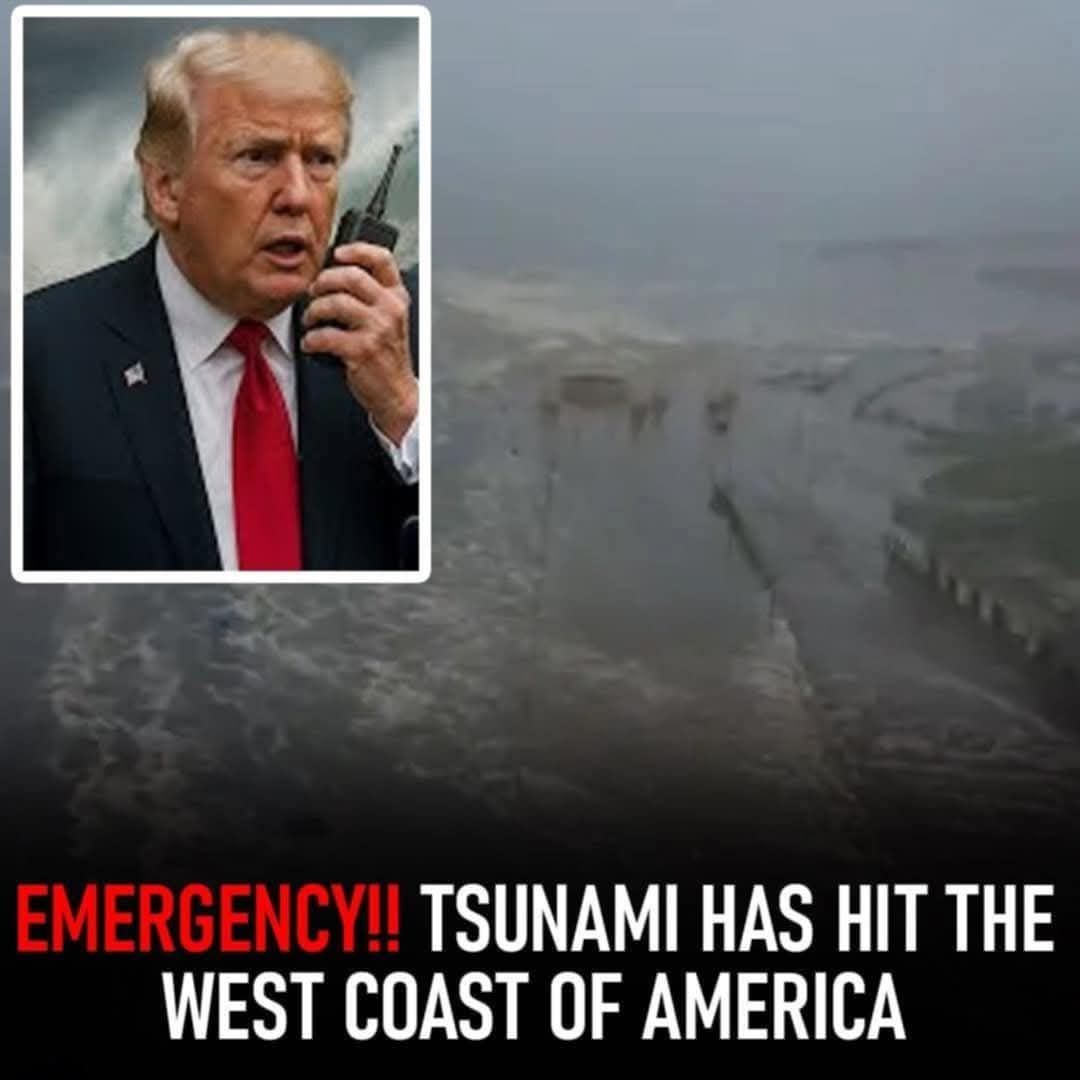On a quiet Tuesday morning, the sky over the Pacific shimmered with deceptive calm. Families were preparing their kids for school, fishermen were casting their nets into tranquil waters, and travelers in beachside resorts were sipping their first coffee of the day. But online, a different kind of storm had already begun brewing. A single tweet—harmless at first glance—declared that a massive undersea earthquake had just struck and that a colossal tsunami, “the largest in modern history,” was racing toward the coastlines of multiple countries. The tweet included fake seismograph images, a fabricated NOAA logo, and a false quote attributed to an “emergency broadcast system.” Within minutes, the post was shared, reposted, screenshotted, and translated into dozens of languages. From Japan to California, Thailand to Chile, panic began to ripple through the internet faster than any natural disaster ever could.
Within the hour, social media platforms became flooded with videos of people fleeing coastal towns—some real, many staged or taken from unrelated incidents. Sirens from past emergencies were recycled and dubbed into TikToks. Old videos of tsunamis were reposted with new captions. Instagram influencers in swimwear posted warnings, hashtagged #TsunamiAlert, and urged their followers to “stay safe and pray.” On Facebook, community groups became digital shelters of shared anxiety, where rumors escalated rapidly: that schools had already been flooded, that evacuation orders were secretly issued, that the government was hiding the true scale of destruction. Some claimed they had “inside sources.” Others referenced “leaked documents.” It didn’t matter that the official meteorological agencies across affected regions had posted zero alerts—the internet had made up its mind. The tsunami was coming. Or rather, it was already here.
Governments scrambled to respond. In the Philippines, dozens of coastal towns saw residents abandon their homes, clogging roads as they rushed to higher ground. In Hawaii, volunteers activated tsunami response protocols, only to find out there was no warning issued by the Pacific Tsunami Warning Center. In California, several beaches were forcibly cleared by panicked local authorities responding to overwhelming public pressure. A false alarm had become a very real disaster—not of water and waves, but of disinformation and digital hysteria. The economic impact was immediate: tourism bookings were canceled, transportation routes disrupted, and small businesses forced to close for the day, costing local economies millions in lost revenue.
What made this incident so uniquely dangerous was not just the hoax itself, but the infrastructure of virality that supported it. The initial tweet was reportedly posted by an anonymous account known for “breaking news,” but the real engine of fear was the algorithmic nature of modern media platforms. Trending hashtags amplified the panic, rewarding the most outrageous or emotional posts with greater visibility. AI-generated images showing fictional flooding scenes in places like Bali, Sydney, and Los Angeles were accepted as truth by the masses. Deepfake videos mimicked news anchors delivering fictional tsunami alerts. The line between truth and fiction didn’t just blur—it dissolved entirely.
And all this unfolded in the span of hours.
This wasn’t the first time a natural disaster had been falsely reported online, but it may have been the most coordinated and convincing. Experts later traced the origins of the hoax to a troll farm suspected to be operating out of Eastern Europe, with evidence suggesting it may have been an experiment in mass disinformation. Whether politically motivated or driven by profit from ad revenue and page views, the impact was undeniable. The digital tsunami, unlike a real one, didn’t retreat after its initial wave. Its aftershocks lingered—distrust in official sources grew, communities remained fearful for days, and thousands of people swore off coastal travel altogether. Misinformation had succeeded where nature had not—it had displaced people, disrupted economies, and sowed chaos.
Psychologists analyzing the incident pointed to a phenomenon they called “panic virality”—a digital mirror of mass hysteria, where fear spreads not through physical contact but through likes, shares, and emotional contagion. In this state, reason gives way to survival instinct, and users are more likely to engage with frightening or urgent content, regardless of its accuracy. Panic virality thrives on visuals: a single AI-generated image of waves crashing over a popular resort received over five million impressions in 12 hours, even though the photo was entirely fake. Videos of people crying, screaming, or praying—all heavily edited or misattributed—were shared in group chats and Discord servers with the ominous message: “It’s happening.”
News outlets were caught in the crossfire. Reputable sources hesitated to cover the tsunami claim, but the sheer volume of online chatter forced them to issue clarifications. Unfortunately, in the age of disinformation, facts often arrive too late. Many people had already accepted the hoax as reality. Some even accused real news outlets of lying or “covering it up.” In one town, residents gathered to protest what they believed was a media blackout. They held signs reading “We Deserve the Truth” and “Don’t Let Us Drown,” unaware that the only flood they were facing was one of manipulated information.
Digital forensics experts later broke down how the hoax spread. It began with a small network of burner accounts that simultaneously posted identical messages in different languages. Bots then boosted engagement, making the posts trend. AI image tools were used to rapidly produce fake “before and after” disaster scenes. YouTube channels edited past footage of real tsunamis with new timestamps. Even weather tracking apps showed manipulated data—likely a result of third-party plug-ins or hijacked APIs. It was a masterclass in weaponizing public fear.
The social implications were even more chilling. In several cases, elderly individuals suffered health complications due to the panic. In one rural coastal village, a woman reportedly died of a heart attack while evacuating. Families were separated as parents rushed children to safety without coordination. A man in Indonesia livestreamed his “final moments,” believing he was about to be swept away, only to later appear in another video, tearful and apologetic. “I believed it. All of it. I really thought this was the end,” he said.
Tech companies responded with belated damage control. Twitter, TikTok, Facebook, and YouTube removed thousands of posts and suspended dozens of accounts, but the harm had already been done. Some platforms added tsunami warning disclaimers. Others adjusted their trending algorithms. But critics argued it was too little, too late. The architecture of panic had already been built—and it would remain standing for the next hoax.
So what can be learned from a fake tsunami that never happened, but still managed to uproot lives? The answer lies in digital literacy, institutional readiness, and platform accountability. Experts stress the need for early intervention systems that detect coordinated disinformation campaigns before they go viral. Some propose integrating official fact-checks directly into social platforms—pop-ups that appear in real time to debunk trending hoaxes. Others call for criminal penalties against those who intentionally manufacture panic. But perhaps the most critical solution lies in public awareness. Just as schools conduct earthquake and fire drills, perhaps it’s time to prepare for disinformation drills—where citizens are trained to pause, verify, and think critically before hitting “share.”
The tsunami hoax of 2025—now infamous among cybersecurity experts—didn’t leave behind broken buildings or drowned cities. It left behind something arguably more insidious: a society made more afraid, more confused, and more divided by the information it consumes. In a world where lies travel faster than seismic waves, the most important survival skill may no longer be physical preparedness—but the ability to think clearly in the face of digital chaos.

